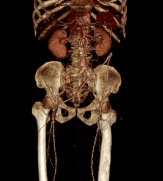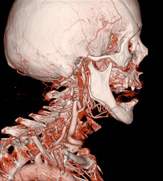Computed Tomography (CT) Scan
- What is a CT scan and how does a CT scanner work?
- What are CT scans used for?
- Preparation for the scan
- Having a CT scan
- Deciding whether to have a CT scan
- Making an appointment
1. What is a CT scan and how does a CT scanner work?
 A CT scanner is a sophisticated machine that uses X-Rays to acquire images of the body. Instead of sending out a single x-ray beam through your body as with ordinary X-Ray examinations, a fan-shaped beam of X-Rays passes through a slice of your body onto a bank of detectors where their strength is measured. Beams that have passed through less dense tissue such as the lungs will be stronger, whereas beams that have passed through denser tissue such as bone will be weaker. A powerful computer will use this information to work out the relative density of the tissues and the results are represented as a cross-sectional, two-dimensional picture shown on a monitor.
A CT scanner is a sophisticated machine that uses X-Rays to acquire images of the body. Instead of sending out a single x-ray beam through your body as with ordinary X-Ray examinations, a fan-shaped beam of X-Rays passes through a slice of your body onto a bank of detectors where their strength is measured. Beams that have passed through less dense tissue such as the lungs will be stronger, whereas beams that have passed through denser tissue such as bone will be weaker. A powerful computer will use this information to work out the relative density of the tissues and the results are represented as a cross-sectional, two-dimensional picture shown on a monitor.
2. What are CT scans used for?
Any part of the body can be examined and CT scanning is particularly good at looking at the following areas:
- Internal organs
- Orthopedic imaging i.e. bones
- Brain imaging
- Vascular imaging
CT scans are far more detailed than ordinary X-Rays. The information gathered is reconstructed to produce three-dimensional images that show what a surgeon would see during an operation. CT scans can very often prevent the need for invasive procedures.
3. Preparation for the scan
For some examinations, no preparation is required, However if you are a patient having a scan of the abdomen, for example, you will be asked not to eat for up to 6 hours before the test. We do however encourage to you to drink plenty of fluids before and after your scan. Sometimes, you will be given a drink containing gastrografin, an aniseed flavoured X-Ray dye, up to an hour before the procedure. This makes the intestines easier to see on the images. In other examinations of the abdomen, you will be given a cup of water to drink immediately prior to the examination. Metal can interfere with the image quality, so everyone who has a scan is asked to remove metal objects.
4. Having a CT scan
 A CT SCAN OF THE HEAD
A CT SCAN OF THE HEAD
Having a CT scan involves lying on a table that slides through the ‘ring' of the scanner. The table is positioned so the part of the body being examined lies within the ring. The table moves through the gantry as the X-Ray source and the detectors rotate around inside. There will be a whirring noise caused by the moving parts of the scanner within the gantry. The radiographer operates the scanner from behind a window, and is able to see, hear and speak to the person being scanned throughout the procedure. The patient will be asked to keep very still and hold their breath for a few seconds. For some examinations, an injection of contrast agent (X-Ray dye) is needed to make organs and blood vessels easier to pick out. It is usually given into a vein in the arm or hand at the beginning of the scan. The total length of a CT scan procedure can vary from between 10 minutes to an hour. The actual scanning itself takes between a few seconds and a few minutes depending upon the examination, so most of the procedure time is in preparation and confirmation that the images are what your consultant needs. Once the examination is over most people can resume their normal activities immediately. The images we record will then be interpreted by a radiologist and the results will be sent to the doctor who arranged the scan.
5. Deciding whether to have a CT scan
A CT scan is safe and a very common procedure. However, in order to give informed consent, all patients deciding whether or not to have this procedure need to be aware of the possible side effects and the risk of complications.
Side-effects
The CT scan itself does not have any physical side effects. However, if a contrast
agent is used, in very rare cases, some people may be affected. As the dye is
injected it can cause flushing of the complexion and sometimes a feeling of
nausea. Some people feel warm and get a metallic taste in their mouth. These
are normal sensations and pass within a few seconds.
Complications
The only complications that may arise from a CT scan are related to the
contrast agent. Again, very rarely a patient may have an allergic reaction to
the dye. This can be treated immediately with appropriate medicines. Also, the
dye can cause further kidney damage in people who already have kidney problems.
People who have allergies or kidney problems should tell the staff prior to the
examination.
Contraindications
If there is any chance that you could be pregnant, you will not be scanned.
6. Making an appointment
In order to have any Imaging procedure you must have a request form. This can be a GP or Consultant Specialist. This is a legal requirement.
 Come and visit us
Come and visit us